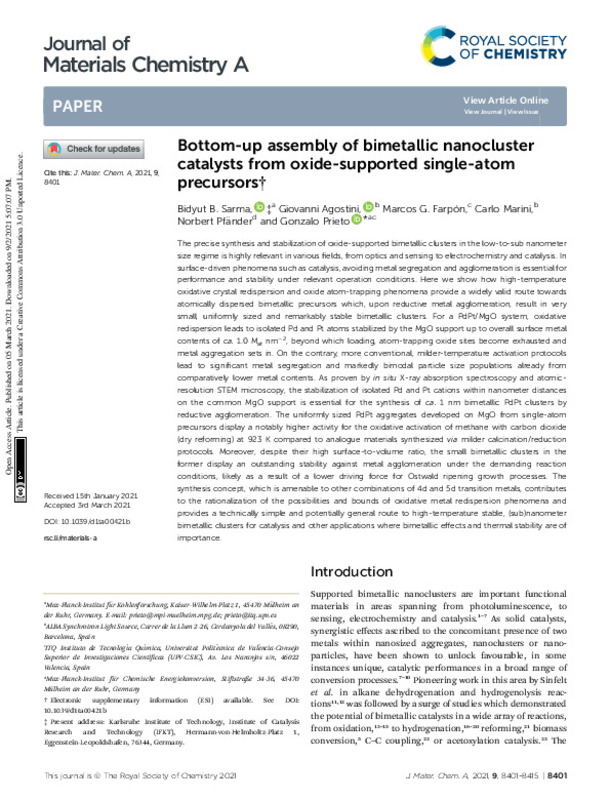JavaScript is disabled for your browser. Some features of this site may not work without it.
Buscar en RiuNet
Listar
Mi cuenta
Estadísticas
Ayuda RiuNet
Admin. UPV
Bottom-up assembly of bimetallic nanocluster catalysts from oxide-supported single-atom precursors
Mostrar el registro sencillo del ítem
Ficheros en el ítem
| dc.contributor.author | Sarma, Bidyut B.
|
es_ES |
| dc.contributor.author | Agostini, Giovanni
|
es_ES |
| dc.contributor.author | Garcia-Farpon, Marcos
|
es_ES |
| dc.contributor.author | Marini, Carlo
|
es_ES |
| dc.contributor.author | Pfaender, Norbert
|
es_ES |
| dc.contributor.author | Prieto González, Gonzalo
|
es_ES |
| dc.date.accessioned | 2022-09-29T18:04:47Z | |
| dc.date.available | 2022-09-29T18:04:47Z | |
| dc.date.issued | 2021-04-07 | es_ES |
| dc.identifier.issn | 2050-7488 | es_ES |
| dc.identifier.uri | http://hdl.handle.net/10251/186752 | |
| dc.description.abstract | [EN] The precise synthesis and stabilization of oxide-supported bimetallic clusters in the low-to-sub nanometer size regime is highly relevant in various fields, from optics and sensing to electrochemistry and catalysis. In surface-driven phenomena such as catalysis, avoiding metal segregation and agglomeration is essential for performance and stability under relevant operation conditions. Here we show how high-temperature oxidative crystal redispersion and oxide atom-trapping phenomena provide a widely valid route towards atomically dispersed bimetallic precursors which, upon reductive metal agglomeration, result in very small, uniformly sized and remarkably stable bimetallic clusters. For a PdPt/MgO system, oxidative redispersion leads to isolated Pd and Pt atoms stabilized by the MgO support up to overall surface metal contents of ca. 1.0 M-at nm(-2), beyond which loading, atom-trapping oxide sites become exhausted and metal aggregation sets in. On the contrary, more conventional, milder-temperature activation protocols lead to significant metal segregation and markedly bimodal particle size populations already from comparatively lower metal contents. As proven by in situ X-ray absorption spectroscopy and atomic-resolution STEM microscopy, the stabilization of isolated Pd and Pt cations within nanometer distances on the common MgO support is essential for the synthesis of ca. 1 nm bimetallic PdPt clusters by reductive agglomeration. The uniformly sized PdPt aggregates developed on MgO from single-atom precursors display a notably higher activity for the oxidative activation of methane with carbon dioxide (dry reforming) at 923 K compared to analogue materials synthesized via milder calcination/reduction protocols. Moreover, despite their high surface-to-volume ratio, the small bimetallic clusters in the former display an outstanding stability against metal agglomeration under the demanding reaction conditions, likely as a result of a lower driving force for Ostwald ripening growth processes. The synthesis concept, which is amenable to other combinations of 4d and 5d transition metals, contributes to the rationalization of the possibilities and bounds of oxidative metal redispersion phenomena and provides a technically simple and potentially general route to high-temperature stable, (sub)nanometer bimetallic clusters for catalysis and other applications where bimetallic effects and thermal stability are of importance. | es_ES |
| dc.description.sponsorship | XAS experiments were performed at the CLAESS BL22 beamline of the ALBA Light Source, Cerdanyola del Vall¿es, Spain: experiment 2019023278. The authors are grateful to beamline staff members, as well as to E. Andr¿es, M. E. Mart¿¿nez-Monje and I. L¿opez-Luque (ITQ) for assistance with XAS measurements. J. Ternieden (MPI-KOFO) is acknowledged for XRD measurements. M. Mayer (MPI-KOFO) is thanked for his assistance with the synthesis of the MgO support. P. N. Plessow and F. Studt (KIT) are gratefully acknowledged for the development of the DFT-optimized structural models used in EXAFS datatting. Authors are grateful to Prof. Ferdi Schuth for providing lab facilities and supportive access to analytical methods at the MPI-KOFO. This research received funding from the Max Planck Society and the Spanish Ministry of Science and Innovation (RTI2018-096399-A-100 and SEV-2016-0683). B. B. S. acknowledges the Alexander von Humboldt Foundation for a postdoctoral grant. M. G. F. acknowledges the Spanish Ministry of Science, Innovation and Universities for a FPU predoctoral scholarship (FPU17/04701). Open Access funding provided by the Max Planck Society. | es_ES |
| dc.language | Inglés | es_ES |
| dc.publisher | The Royal Society of Chemistry | es_ES |
| dc.relation.ispartof | Journal of Materials Chemistry A | es_ES |
| dc.rights | Reconocimiento (by) | es_ES |
| dc.subject | Chemistry | es_ES |
| dc.subject | Energy & Fuels | es_ES |
| dc.subject | Materials | es_ES |
| dc.subject | Science | es_ES |
| dc.subject.classification | INGENIERIA QUIMICA | es_ES |
| dc.title | Bottom-up assembly of bimetallic nanocluster catalysts from oxide-supported single-atom precursors | es_ES |
| dc.type | Artículo | es_ES |
| dc.identifier.doi | 10.1039/d1ta00421b | es_ES |
| dc.relation.projectID | info:eu-repo/grantAgreement/AEI/Plan Estatal de Investigación Científica y Técnica y de Innovación 2017-2020/RTI2018-096399-A-I00/ES/CLUSTERES MULTIMETALICOS Y SUBNANOMETRICOS SOPORTADOS: SINTESIS, ESTRUCTURA Y DINAMISMO ATOMICO, Y EMPLEO COMO CATALIZADORES EN LA VALORIZACION DE METANO Y ALCANOS LIGEROS/ | es_ES |
| dc.relation.projectID | info:eu-repo/grantAgreement/MCIU//FPU17%2F04701/ | es_ES |
| dc.relation.projectID | info:eu-repo/grantAgreement/MCIU//SEV-2016-0683/ | es_ES |
| dc.rights.accessRights | Abierto | es_ES |
| dc.contributor.affiliation | Universitat Politècnica de València. Instituto Universitario Mixto de Tecnología Química - Institut Universitari Mixt de Tecnologia Química | es_ES |
| dc.description.bibliographicCitation | Sarma, BB.; Agostini, G.; Garcia-Farpon, M.; Marini, C.; Pfaender, N.; Prieto González, G. (2021). Bottom-up assembly of bimetallic nanocluster catalysts from oxide-supported single-atom precursors. Journal of Materials Chemistry A. 9(13):8401-8415. https://doi.org/10.1039/d1ta00421b | es_ES |
| dc.description.accrualMethod | S | es_ES |
| dc.relation.publisherversion | https://doi.org/10.1039/d1ta00421b | es_ES |
| dc.description.upvformatpinicio | 8401 | es_ES |
| dc.description.upvformatpfin | 8415 | es_ES |
| dc.type.version | info:eu-repo/semantics/publishedVersion | es_ES |
| dc.description.volume | 9 | es_ES |
| dc.description.issue | 13 | es_ES |
| dc.relation.pasarela | S\444874 | es_ES |
| dc.contributor.funder | Max Planck Society | es_ES |
| dc.contributor.funder | Agencia Estatal de Investigación | es_ES |
| dc.contributor.funder | Alexander von Humboldt Foundation | es_ES |
| dc.contributor.funder | Ministerio de Ciencia, Innovación y Universidades | es_ES |








